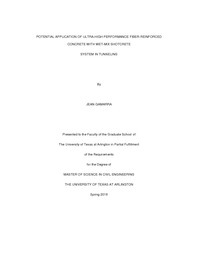
ATTENTION: The works hosted here are being migrated to a new repository that will consolidate resources, improve discoverability, and better show UTA's research impact on the global community. We will update authors as the migration progresses. Please see MavMatrix for more information.
Show simple item record
| dc.contributor.advisor | Najafi, Mohammad | |
| dc.creator | Gamarra, Jean | |
| dc.date.accessioned | 2016-07-08T20:43:44Z | |
| dc.date.available | 2016-07-08T20:43:44Z | |
| dc.date.created | 2016-05 | |
| dc.date.issued | 2016-05-31 | |
| dc.date.submitted | May 2016 | |
| dc.identifier.uri | http://hdl.handle.net/10106/25794 | |
| dc.description.abstract | In the tunneling industry, shotcrete has been used for several decades. The use of shotcrete or wet-mix spray-on methods allows the application of this method in complex underground profiles and shapes. The need for time efficient spraying methods and constructability for lining coverage opens the door for technologies like steel and synthetic fiber reinforced shotcrete to achieve a uniform and a good quality product. An important advantage of the application of fiber reinforced concrete in shotcrete systems for tunneling is that almost no steel fixing is required. This leads to several other advantages including safer working conditions during excavation, less cost, and higher quality achieved through the use of this new technology. However, there are still some limitations. This research presents an analysis and evaluation of the potential application of a new R&D product, ultra-high-performance fiber-reinforced concrete (UHP-FRC), developed by UTA associate professor Shih-Ho (Simon) Chao. This research will focus on its application to tunnel lining using a wet-mix shotcrete system. The objectives of this study are to evaluate the potential application of UHP-FRC with wet-mix shotcrete equipment. This is the first time UHP-FRC has been used for this purpose; hence, this thesis also presents a preliminary evaluation of the compressive and tensile strength of UHP-FRC after application with shotcrete equipment, and to identify proper shotcrete procedures for mixing and application of UHP-FRC. A test sample was created with the wet-mix shotcrete system for further compressive and tensile strength analysis and a proposed plan was developed on the best way to use the UHP-FRC in lining systems for the tunneling industry. As a result of this study, the viscosity for pumpability was achieved for UHP-FRC. However, the mixer was not fast enough to efficiently mix this material. After 2 days, material strength showed 7,200 psi, however, vertical shotcrete was not achieved due to the flowability of the material. Further research with dry-mix shotcrete is recommended. | |
| dc.format.mimetype | application/pdf | |
| dc.language.iso | en_US | |
| dc.subject | UHP-FRC | |
| dc.subject | Ultra high performance fiber-reinforced concrete | |
| dc.subject | Shotcrete | |
| dc.subject | Concrete | |
| dc.subject | Gunite | |
| dc.title | POTENTIAL APPLICATION OF ULTRA-HIGH PERFORMANCE FIBER-REINFORCED CONCRETE WITH WET-MIX SHOTCRETE SYSTEM IN TUNNELING | |
| dc.type | Thesis | |
| dc.degree.department | Civil Engineering | |
| dc.degree.name | Master of Science in Civil Engineering | |
| dc.date.updated | 2016-07-08T20:44:15Z | |
| thesis.degree.department | Civil Engineering | |
| thesis.degree.grantor | The University of Texas at Arlington | |
| thesis.degree.level | Masters | |
| thesis.degree.name | Master of Science in Civil Engineering | |
| dc.type.material | text | |
| dc.creator.orcid | 0000-0002-7926-4281 | |
Files in this item
- Name:
- GAMARRA-THESIS-2016.pdf
- Size:
- 3.455Mb
- Format:
- PDF
This item appears in the following Collection(s)
Show simple item record


